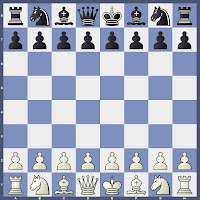Light squares...light squares! - Aeroflot Round - 5
".....a weakness of the light squares leads to the weakness of the men on dark squares. Likewise, a weakness of dark squares meant that the pieces on the light squares are also weak"
- David Bronstein
At times, one feels that the possibility of "agreed draw" may have depraved (let me bear the guilt of this strong and wrong choice of adjective) this great game of chess....a bit....
......for, it may of exposed more human-side of this game and showcased its ability to wax and wane in tune with time and transitions.....even within that limited frame of a game!
This has no particular reference to the high percentage of draws in this particular round....but a general anguish.
The problem with allowing the game only to finish logically on the board either through a side getting mated or a side losing on time (which is remote with the increment) letting only two Kings remain finally - which will be the only draw, is that, 'what happens to the still unfinished struggle even after a stipulated time or what if both players keep pushing woods endlessly!? The arbiter and the tournament organisers also have a home and a family apart from.....!
Hence, let us grudgingly accept this option - which incidentally is available only for this noble game!
Choosing a game to write about is an interesting and time consuming task! Generally, a reader would like to see a game with lot of tactical finesses but one should never forget that the tactics are mere tools......a culmination of a well laid out strategic plan and never operate in isolation.
I, for one, abhor this dichotomy for I believe that they are the two sides of the same coin and operate together with the presence of the other in silence!
Alan Pichot - Denis Khismatullin - Aeroflot, 2016
White played....
14.h4?!
Probably, this "?!" would have been more appropriate to his previous move...13.Qd2.
We shall see a snapshot of a few positions now to understand this position a little better.
Bent Larsen - Murray Chandler, Naestved; 1985
A nice position from White's point of view and probably one of the precursors for Black opting to play 7.....h5!?
Black was so pissedoff with the position and he chose to part with his light squared Bishop for one of those galloping Knights which dominate White's pawnless center, rendering his pieces on the dark square behind, remain very passive! Yet, he did not get any respite..... and even after the exchange of the Queens, the indomitable Bishop, which later stood on 'd5 square, exerted huge pressure on all the light squares on that d5 -a8 & d5-g8 diagonals to decide the issue.
Anatoly Karpov - Vassily Ivanchuk, Buenos Aires; 1994
Karpov had dealt with this set-up with his customary great ability to spot the changing situations on the board and readjusting his strategy, but yet, in the above position, when he was offered the chance to exert some pressure on Black's position (Black had just played 22.....Qb7-b6, releasing the pressure on e4 a bit!), chose to play 23.Qf3 here and after Ra3! was quick to realise the seriousness of what would befall on the weakened Queenside (with that b2-b4) and bailed out with....24.Bf6!? Bf6; 25.Rd3 h4; 26.Rd6 Be7; 27.Rd3 Bb4; 28.gh4 Be7; 29.h5 b4; 30.Nd5!
A very interesting game, in tune with the game under contention was played between....
Alexie Shirov - Sanan Sjugirov; Russian Ch - 2013
While Pichot was busy doing something, Shirov had done something else to achieve this position! In a principled way, Shirov solved the problem of his Knight placement, without moving the Queenside pawns in a weakening manner!
As you can see, White has obtained a robust position and after 15....Nd5; 16.ed5 Qg6; 17.h4 f6; 18.Be3 f5; 19.Bg5! Nf6; 20.a4 OO; 21.ab5 ab5; 22.OO Ne4; 23.Ra7! Ba8; 24.Be3 Rf7?! 25.Ra5! got a nice initiative and went on to win a fine game!
Coming back to the game between Pichot and Khismatullin....
14.....Re8; 15.Rfd1?!
More important than this was to find a way to put that Knight on e2 on a better square and better use.
15....Qc7; 16.b3?
This is out of place and instead of blaming some other move later, for what happened then, it would be appropriate to reprimand this one. White has been dealing with the opening play in a very unprincipled way.....
16.....Qb8; 17.Rac1? b5;
Perhaps, Black could have delayed this....having equalised comfortably, Black now seeks to seize the initiative! Nothing wrong!
18.ab5 ab5; 19.Nb5 Ne4?!
Instead, why not 19....Be4!? when capturing on d6 would enable Black to capture on c2 after exchange of that Knight; and reach a position similar to what happened in the game!
20.Be4 Be4; 21.Nd6?
21.Nec3! would have given some role to that Knight....perhaps a serious one as Black may even land in some trouble; as the Knight is attacking the light squared Bishop and has covered his weakness, whilst defending the one on b5 - one move accomplishes so many things! And the d6 has turned into a chronic weakness, suddenly!
Such is the fleetingness of every passing moves in chess as with the every passing moments in life!
One needs to stay aware....always....aware to each and every new possibility that may open up after every move of your opponent....before considering yours!
21.....Bd6; 22.Qd6 Rc7; 23.Nc3
A bit too late....the position has drifted meanwhile!
23.....Rc3; 24.Qd7 Rec8; 25.Qd6 Qb5!
Suddenly, dark clouds gather around the light squares....especially near White's King!
26.Re1 Ba8! 27.Ra1 Qb7; 28.Ra8 Qa8; 29.Qe5 Rc2; 30.Be3?! Re8; 31.Qh5?
Though White's position is anyway very bad, this loses instantly in a piquant way!
31.....Re3!
White Resigned







.jpg)
.jpg)

Comments
Post a Comment